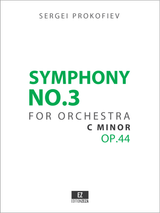
Prokofiev's Symphony No. 4 is actually two works, both using material created for The Prodigal Son ballet. The first, Op. 47, was completed in 1930 and premiered that November; it lasts about 22 minutes. The second, Op. 112, is too different to be termed a "revision"; made in 1947, it is about 37 minutes long, differs stylistically from the earlier work, reflecting a new context, and differs formally as well in its grander instrumentation.
The First Version (Op.47) is available here.
In early 1947, Prokofiev was presented with the idea of revising his Symphony No. 4 Op. 47. The idea appealed to him for several reasons. First, the original version had never had much success (especially in the Soviet Union), but Prokofiev believed that the material had great potential. Second, he had just had great success with his Symphony No. 5 in B-flat major, and he hoped to reshape No. 4 in its image. Symphony No. 5 in B-flat major had been in the style of socialist realism, so many of the changes in the revision lent the new work a more expansive and heroic feel. The revision altered the original so thoroughly that Prokofiev felt that it was a new work; thus the new opus number, 112. In the summer of 1947, when the revisions took place, he also orchestrated Symphony No. 6 and wrote two propaganda pieces: Festive Poem and Flourish, O Mighty Land, both works for large forces.
In a review of Neeme Järvi's recordings of Prokofiev's Third and Fourth Symphonies, Robert Cummings states that: Opinion among musicologists and critics has tended to favor the earlier work, but conductors have shown a marked preference for the expanded version in both the concert hall and recording studio.
This statement is substantiated by the fact that there are twice as many recordings available of Opus 112 as there are of Opus 47. Robert Layton offers another perspective on the relationship between the two versions in his review of the Fourth Symphony. It provides some insight into the relative neglect that Opus 47 has felt, in comparison to the more monumental Opus 112: It is generally agreed that the transformation from dance to symphony in the Fourth is accomplished with less success than is the metamorphosis from The Flaming Angel to the Third Symphony, and whether in reworking the 1930 version Prokofiev wholly succeeded remains open to question. Let us hope that the appearance of these scores presages a resurgence of interest in Prokofiev's Paris years, for works such as the now neglected Quintet, Op. 39, and the almost forgotten Divertissement for orchestra, Op. 43, deserve a far more prominent place in the repertory.
- Difficulty:
- Advanced
- Instrumentation:
- Picc,2Fl, 2Ob, CA, ClEb, 2Cl, BCl, 2Bsn, Cbsn, 4Hn, 3Tpt, 3Tbn, Tba, Timp, Perc(3), Pno, Harp, Strings
- Duration:
- 37 min.
- Set of Parts:
- Includes Strings count 4.4.3.3.2
- Extra Strings:
- Only available with the purchase of the Set of Parts






